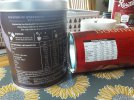MrsA2
Expert
- Messages
- 6,931
- Type of diabetes
- Type 2
- Treatment type
- Diet only
A relative bought a tin of luxury branded hot chocolate saying it was just chocolate to melt as the main ingredient listed is "chocolate powder", however as the claim on the front was 42% cocoa my scepticism was triggered. What was the other 58%?
Here's the nutrition label next to one of cocoa powder.
Firstly they've shown the amount per 100ml with 2 asterisks, (not the usual 100g). That refers you to small print at the bottom which says that's 100ml of product prepared as instructions ie with semi skimmed milk.
But the instructions make up double the amount listed in that first column, the one that usually shows per 100g.
The hot chocolate uses 20g of the powder and makes a mug with 22 g carbs when made up with milk.
It takes maths to work out carbs per 100g.
If we assume 10g carbs for the milk, then the difference must be 12g carb for 20g of product so its actually 60g carbs per 100g (12×5), as much as a breakfast cereal
The ingredients just list "chocolate powder", cocoa powder and a thickener/stabiliser so it's impossible to see just how much sugar or sugar substitute is in there by checking the ingredients list.
A Serving is 22g carbs whereas using cocoa powder a serving is just over 10g, most of which is the milk.
I don't think they've done anything illegal, it's just really cleverly hidden how much sugar is in the product .
I know many of the regulars on here know this sort of thing but I thought this was a cautionary example for newbies.

Here's the nutrition label next to one of cocoa powder.
Firstly they've shown the amount per 100ml with 2 asterisks, (not the usual 100g). That refers you to small print at the bottom which says that's 100ml of product prepared as instructions ie with semi skimmed milk.
But the instructions make up double the amount listed in that first column, the one that usually shows per 100g.
The hot chocolate uses 20g of the powder and makes a mug with 22 g carbs when made up with milk.
It takes maths to work out carbs per 100g.
If we assume 10g carbs for the milk, then the difference must be 12g carb for 20g of product so its actually 60g carbs per 100g (12×5), as much as a breakfast cereal
The ingredients just list "chocolate powder", cocoa powder and a thickener/stabiliser so it's impossible to see just how much sugar or sugar substitute is in there by checking the ingredients list.
A Serving is 22g carbs whereas using cocoa powder a serving is just over 10g, most of which is the milk.
I don't think they've done anything illegal, it's just really cleverly hidden how much sugar is in the product .
I know many of the regulars on here know this sort of thing but I thought this was a cautionary example for newbies.

